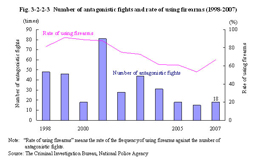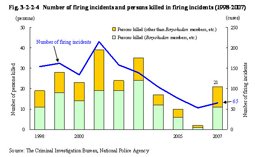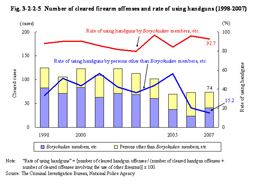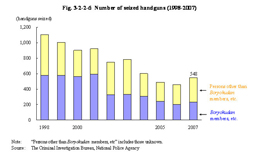| Previous Next Index Image Index Year Selection | |
|
|
2 Firearm offenses Fig. 3-2-2-3 shows the number of antagonistic fights amongst Boryokudan and the rate of using firearms (firearms mean handguns, rifles, machine guns, cannons, hunting rifles and other guns which have the function of firing metal bullets, and air guns; hereinafter the same) (the rate of frequency in the usage of firearms in comparison to the total number of antagonistic fights) over the last 10 years. Fig. 3-2-2-3 Number of antagonistic fights and rate of using firearms (1998–2007) Fig. 3-2-2-4 shows the number of firing incidents and persons killed in firing incidents over the last 10 years.Fig. 3-2-2-4 Number of firing incidents and persons killed in firing incidents (1998–2007) (2) Trends in clearance of offenses involving the use of firearmsFig. 3-2-2-5 shows the number of cleared firearm offenses and the rate of using handguns over the last 10 years. Fig. 3-2-2-5 Number of cleared firearm offenses and rate of using handguns (1998–2007) (3) Trends in seizure of handgunsFig. 3-2-2-6 shows the number of handguns seized over the last 10 years. Fig. 3-2-2-6 Number of seized handguns (1998–2007) In 2007, the number of seized handguns increased by 90 (19.7%) from the previous year to 548, among which genuine handguns were 513 (93.6%).Breaking down the country of manufacture for the genuine 513 handguns seized in 2007, the U.S.A. had the largest share with 153, followed by Japan with 64, Belgium with 32, China with 31, Russia with 26, Italy with 22, Philippines with 21, and Germany with 21 (Source: The Criminal Investigation Bureau, National Police Agency). |



